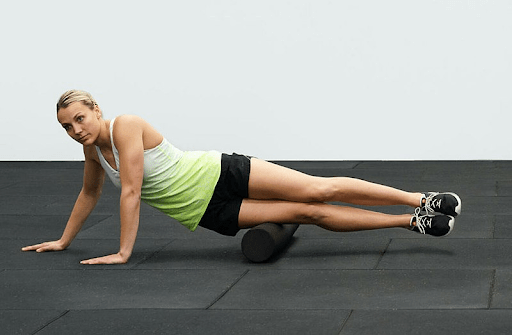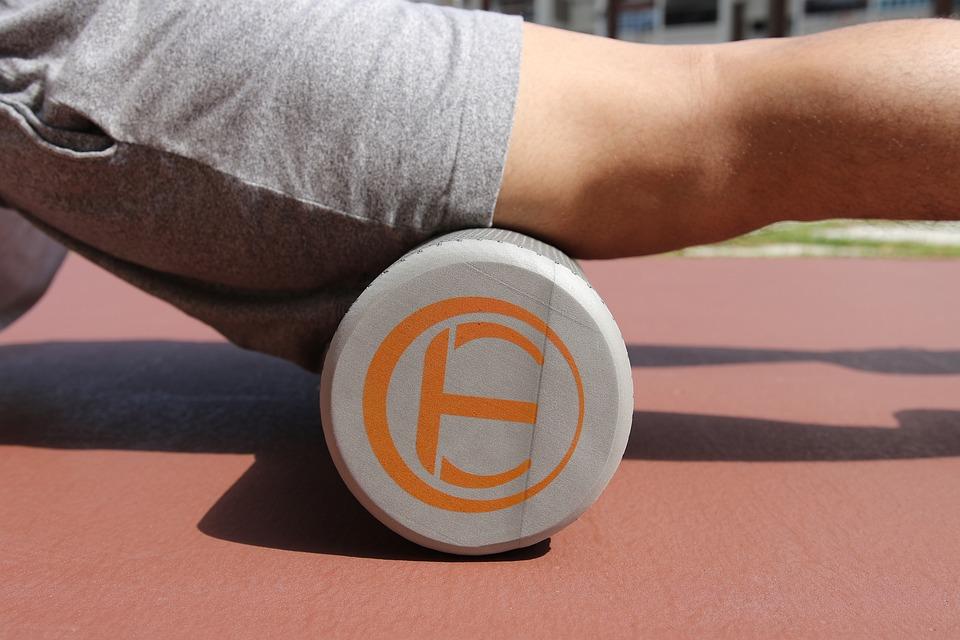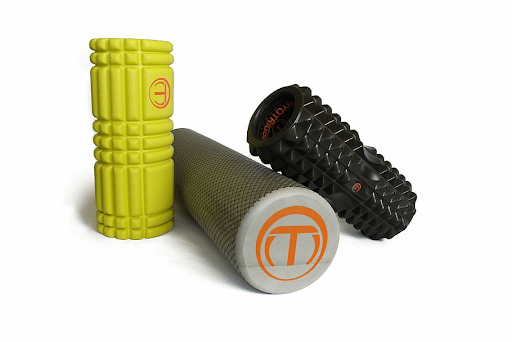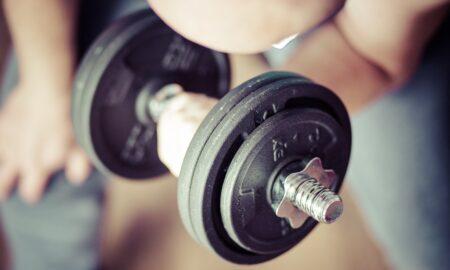

Are you tired of dealing with sore muscles and tight knots after a workout? Or do you spend hours sitting at a desk and suffer from lower back pain? If so, then a foam roller might be a simple and effective way to help you relieve these problems.
Foam rollers have become increasingly popular as a go-to tool for self-myofascial release. Not only is it an effective tool to relieve muscle tension and soreness, but it also helps improve flexibility, mobility, and overall athletic performance.
To learn more about foam rollers, this article will explore the many benefits of a foam roller and why you should consider incorporating it into your daily routine. So, let’s dive in and discover why you should use a foam roller.
What is a Foam Roller?
A foam roller is a self-myofascial release tool that aims to release tension, relieve soreness and inflammation, increase the range of motion and loosen up tight muscles and fascia (the connective tissue surrounding muscles). The act of using a foam roller is called foam rolling.
Foam rollers come in various shapes, sizes, and even materials. However, most come cylindrical with a 1-4 feet length and 5-10 inches diameter. They are made of dense foam and different firmness levels and have tender spots that may can make you uncomfortable when rolling on them.
To perform foam rolling, you place a foam roller on the ground and use your body weight to apply pressure to the targeted area. When foam rolls, the receptors send signals to your nervous system through the spinal cord. The nervous system gets stimulated and sends signals to the surrounding muscles to release tension and increase the range of motion.
Foam rolling properly also increases blood circulation, helping deliver crucial nutrients and oxygen to the muscles.
Foam rolling is an effective technique to add to your workout as a warm-up and cool-down before and after the training.
Benefits of Foam Rollers (Foam Rolling)
The following are the benefits you can reap from using foam rollers.
Relieve Muscle Pain
After working out you are more likely to feel pain, soreness, tight muscles, or knots. Most bodybuilders ignore all these pains, but they can still hinder your performance on your next workout.
Foam rollers are a great tool for relieving muscle tightness and pain. They work by applying pressure to targeted areas of the body, which helps to break up adhesions and knots in the fascia, loosening muscles and reducing stiffness and pain.
According to research, foam rolling after an intense workout can reduce the intensity of delayed onset muscle soreness and increase your performance.
Also, the breakage of knobs and prevention of adhesion by foam rollers enhances blood flow to the targeted area. This promotes muscle relaxation, reducing inflammation, muscle pain, and soreness.
Improve Flexibility and Range of Motion
Lifting heavy weights and focusing on hypertrophy can sometimes lead to tight muscles, restricted range of motion, and limited flexibility, increasing the risk of injury and limiting performance.
Foam rolling before an exercise can help your muscles relax. As mentioned, foam rollers stimulate your nervous system to loosen the muscles and the surrounding area you are rolling. As the muscles relax, the fibers lengthen from a tight to an elongated state, increasing the range of motion and flexibility around the targeted area.
Furthermore, the study found that applying pressure to specific body areas with foam rollers and static stretching can help break up knots and adhesions within the muscle tissue that can limit flexibility and range of motion. This leads to relaxation and flexibility.
With an increased range of motion, you can perform exercises with better form, target more muscle fibers, and achieve greater muscle stretch and contraction, leading to better muscular development.
Increases Circulation
Foam rolling can improve cardiovascular health by increasing blood flow and oxygen circulation.
Under normal conditions, the body’s fascia, tendons, and ligaments receive very little blood flow. Also, the arteries may become stiffer as we age, making it hard for blood to flow smoothly.
Foam rollers can help reduce arteries’ stiffness and increase the circulation of blood, oxygen, and other nutrients to the needed muscles. Putting pressure on the targeted muscle and fascia helps break up knots and trigger points (areas of tension) that can contribute to the artery’s stiffness, which can increase blood flow to the targeted area.
Since the blood flow carries oxygen and other crucial nutrients, their circulation also improves.
Reduces Injury Risk
Working out without warming up increases your chances of injury since the muscles are still tight.
To reduce the chances of injury, add foam rolling to your workout routine as a warm-up exercise, particularly if you’ve been inactive for a few hours before your workout.
The friction of foam rollers against the muscles you are rolling produces heat that warms up your muscles, loosening them. Warm tissues are more elastic and less likely to be injured.

Speedy Recovery
Foam rolling is thought to cause speedy recovery to the affected area. It loosens the stiffer muscles, breaks the knob, and prevents adhesion, which helps to increase blood flow to the muscles.
The increased blood circulation brings in more oxygen and nutrients that are crucial for the healing of muscles and removes waste products such as lactic acid, which can aid in the recovery process.
According to studies, foam rolling after working out may help to decrease muscle soreness and discomfort.
Improved Posture
Maintaining good posture is vital for your overall health and well-being. Poor posture can lead to problems such as muscle imbalances, injury, back pain, and reduced mobility.
A foam roller can be an effective tool to help improve posture by releasing tension in tight muscles, promoting better alignment and relaxation.
Reduces Stress and promotes Relaxation
Foam rollers also have psychological effects on your body. When you have stress, tension can build up in the muscles and fascia, causing stiffness, pain, and reduced mobility which can cause stress. When you use a foam roller to pressure the targeted area, you loosen tight muscles as it helps release muscle tension. As a result, you feel more relaxed and calmer.
Foam rolling also breaks knots and prevents adhesion. Breaking tighter muscles increases blood circulation, oxygen, and other nutrients. This can help to reduce inflammation, improve immune function, and promote overall well-being.
Increases Performance
Foam rolling can also help improve athletic performance since it improves flexibility, reduces muscle pain and soreness, and promotes better recovery after a workout.

Risk of Using Foam Rollers
Foam rollers are great workout tools for those with tight muscles and those working out constantly. However, it has some risks, such as:
Increased pain or injury
A foam roller can sometimes worsen pain or injury if used on an inflamed or injured area. For instance, it can cause more damage to injuries such as muscle tears or breaks. Avoid using a foam roller on areas that are already painful or injured, and If you must use a foam roller, consult your physical therapist or doctor for clearance first.
Muscle Damage
Foam rollers can sometimes cause soreness or damage small joints such as knees, ankles, and elbows. Also, applying too much pressure on sensitive areas such as the lower back or neck can cause serious damage.
It’s important to start with gentle pressure and gradually increase the intensity. Also, avoid rolling directly over bony areas such as elbows and ankles or areas with thin skin such as legs.
Nerve damage
Foam rollers can cause nerve damage as they can cause load and stress to the underlying tissues such as nerves, blood and lymphatic vessels, and skin receptors.
Unless specifically instructed by your medical practitioner, if you have diseases like varicose veins, severe osteoporosis, advanced diabetes mellitus, and lymphedema, you should refrain from using this kind of workout tool.
Also, foam rolling on areas that run close to the skin’s surface, such as the outside of the thigh or the wrist, is not advisable as it can compress or irritate the nerves. So avoid rolling directly over nerve pathways, and use caution when using a foam roller.
Premature Labour
Although foam rolling may relieve tension during pregnancy, it may cause premature labor, especially when foam rolling in your third trimester. If you feel foam rolling, check with your doctor first and avoid foam rolling while lying on your back and calves in your last trimester.

How to Choose a Foam Roller?
There is no specified way to choose a foam roller. It may take trial and error before selecting the one that suits your needs. But to be on the right start, consider the size and shape of the roller.
For instance, a shorter roller is more effective and suitable for small areas of your body, such as calves or arms. It’s also portable.
Below are various types of foam rollers you can choose from.
Textured Roller
Textured rollers have ridges and knobs on the surface to offer intense pressure to work out knots and adhesion deeply in the muscles. They are more expensive than smooth rollers.
Smooth Roller
The smooth roller has a soft, dense surface foam. It provides even pressure and texture and is less intense than the textured roller. It is less expensive and suitable for those new to foam rolling.
Vibrating Foam Roller
This is the latest foam roller on the market. It improves body circulation, muscle relaxation, and therapeutic recuperation by combining the vibrating effects of a massage gun with a foam roller. An example of a vibrating foam roller is Theragun Wave Duo.
Other foam rollers you can find online are:
- Foam-covered massage sticks— They effectively massage legs or upper back.
- Foam massage balls— You can use them to massage targeted muscle areas, such as working out the knots in your shoulders.
Conclusion
Using a foam roller can benefit your physical health and well-being. It can help alleviate muscle soreness, increase flexibility, and improve overall performance in your daily activities or exercise routine.
Additionally, foam rollers can aid in injury prevention and recovery, making them a valuable tool for athletes and fitness enthusiasts.
If you haven’t tried foam rolling yet, try it!
Start by investing in a high-quality foam roller that suits your needs and fitness level. Then, integrate foam rolling into your pre-workout and post-workout routines, or use it as a standalone recovery tool on rest days. With consistent use, you’ll experience the many benefits foam rollers offer.






















You must be logged in to post a comment Login